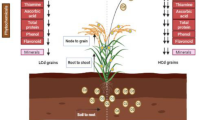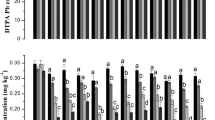Abstract
The rubber-based intercropping management system (RBIS) land management using chemical fertilizer and herbicides cause heavy metal accumulation in soil. Rice is a good heavy metal bioindicator to monitor soil quality and often integrated with RBIS while rubber trees are young as subsistence farming. Heavy metal accumulation in soil and hill paddy grown on former rubber land and specialized paddy field (control) had been assessed to determine whether harvested rice grain poses toxicity risk. Grain harvested from specialized paddy land was safer to consume as none of the selected heavy metal concentrations in rice grain had exceeded the permissible limit of Malaysia Food Regulation 1985 (MFR 1985). Meanwhile, hill paddy grown intercropping with young rubber trees on former rubber land had accumulated a high amount of heavy metals in rice grain whereby nonessential heavy metals like arsenic, cadmium and lead had exceeded the permissible limit of MFR 1985. Commonly, indigenous hill paddy belongs to tall paddy variety group can grow more than 120 cm tall. All harvested hill paddy landraces grown on specialized paddy field surpassed 120 cm. Nevertheless, all hill paddy landraces that were cultivated in former rubber land were below 100 cm tall indicated that heavy metal phytotoxicity occurred in plants. Rice grain produced in former rubber land poses toxicity risk to consumers due to unsustainable conventional agricultural management practice. Soil degradation needs to be prevented as it can impact food safety and food security. Further soil remediation requirement must be determined to ensure high productivity and safety.




Similar content being viewed by others
References
Abdul Halim NA, Abdullah R, Karsani SA, Osman N, Panhwar QA, Ishak CF (2018) Influence of soil amendments on the growth and yield of rice in acidic soil. Agronomy 8:165. https://doi.org/10.3390/agronomy8090165
Abdulla I, Mohamed Arshad F (2017) Exploring relationships between rubber productivity and R&D in Malaysia. Outlook Agric 46(1):28–35. https://doi.org/10.1177/0030727016689731
Alamgir M, Campbell MJ, Sloan S, Engert J, Word J, Laurence WF (2020) Emerging challenges for sustainable development and forest conservation in Sarawak, Borneo. PLoS ONE 15(3):e0229614. https://doi.org/10.1371/journal.pone.0229614
Alrawiq N, Khairiah J, Latif MT, Ismail BS (2015) The distribution and accumulation status of heavy metals (Pb, Cd, Cu and Zn) in soils from the rice fields of MADA in Kedah. Malaysia Int J Chem Sci 13(1):265–283
Alves LR, Reis ARD, Gratao PL (2016) Heavy metals in agricultural soils: from plants to our daily life (a review). Cientifica 44(3):346–361
Arao T, Ae N (2003) Genotypic variations in cadmium levels of rice grain. Soil Sci Plant Nutr 49(4):473–479. https://doi.org/10.1080/00380768.2003.10410035
Cattani I, Romani M, Boccelli R (2008) Effect of cultivation practices on cadmium concentration in rice grain. Agron Sustain Dev 28:265–271. https://doi.org/10.1051/agro:2007033
Chen L, Wu W, Han F, Li J, Ye W, Fu H, Yan Y, Ma Y, Wang Q (2019) Agronomic management and rice varieties controlling Cd bioaccumulation in rice. Int J Environ Res Public Health 16(13):2376. https://doi.org/10.3390/ijerph16132376
Chong ETJ, Goh LPW, Wong JJ, Aziz ZA, Surugau N, Abd. Latip M, Lee PC, (2018) Genetic diversity and relationship of Sabah traditional rice varieties as revealed by RAPD markers. Pertanika J Trop Agric Sci 41(1):177–190
Crowther A, Lucas L, Helm R, Horton M, Shipton C, Wright HT, Walshaw S, Pawlowicz M, Radimilahy C, Douka K, Picornell-Gelabert L, Fuller DQ, Boivin NL (2016) Ancient crops provide first archaeological signature of the westward Austronesian expansion. PNAS 113(24):6635–6640. https://doi.org/10.1073/pnas.1522714113
Fu Y, Brookfield H, Guo H, Chen J, Chen A, Cui J (2009) Smallholder rubber plantation expansion and its impact on local livelihood, land use and agrobiodiversity, a case study from Daka, Xishuangbanna, southwestern China. Int J Sustain Dev World Ecol 16(1):22–29. https://doi.org/10.1080/13504500902753246
Gimeno-Garcia E, Andreu V, Boluda R (1996) Heavy metals incidence in the application of inorganic fertilizers and pesticides to rice farming soils. Environ Pollut 92(1): 19–25. https://doi.org/10.1016/0269-7491(95)00090-9
Hamdan DDM, Roslan NN, Rahim SA (2019) Heavy metals bioavailability under aerobic and anaerobic condition in soil and Bubut rice plant cultivated at Crocker Range, Borneo (Malaysia). J Adv Agric Tech 6(3):187–193. https://doi.org/10.18178/joaat.6.3.187-193
Hamdan DDM, Roslan NN, Mohd Azman AS, Musa F (2018) Trace elements distribution in heirloom paddy pandasan cultivated under field conditions of dry and wet soil. AGROFOR Int J 3(3):90–97. https://doi.org/10.7251/AGRENG1803090M
Hashmi MI, Tianlin JS (2016) Mineral contents of some indigenous rice varieties of Sabah Malaysia. Int J Agric For Plant 2:31–34
Hondrade RF, Hondrare E, Zheng L, Elazegui F, Dugue JLJE, Mundt CC, Vera Cruz CM, Garrett KA (2017) Cropping system diversification for food production in Mindanao rubber plantations: a rice cultivator mixture and rice intercropped with mungbean. PeerJ 8: e2975. https://doi.org/10.7717/peerj.2975
Hseu ZY, Su SW, Lai HY, Guo HY, Chen TC, Chen ZS (2010) Remediation techniques and heavy metal uptake by different rice varieties in metal-contaminated soils of Taiwan: new aspects for food safety regulation and sustainable agriculture. Soil Sci Plant Nutr 56:31–52. https://doi.org/10.1111/j.1747-0765.2009.00442.x
Ibrahim KN, Yet ZR, Md. Som A, Razali N, Mohamed Rahaizah NA, Othman EN, Burok NA, Mohd Yunos Y, Othman R, Tengku Yahya TF (2015) Heavy metal concentration (Pb, Cu, Fe, Zn, Ni) in plant parts of Zea Mays L. cultivated in agricultural area near Alor Gajah, Melaka, Malaysia. American Journal of Environmental Engineering 5(3A):8–12. https://doi.org/10.5923/c.ajee.201501.02
Ishikawa S, Makino T, Harada K, Nakada H, Nishida I, Nishimura M (2016) Low-cadmium rice (Oryza sative L.) cultivator can simultaneously reduce arsenic and cadmium concentrations in rice grains. Soil Sci Plant Nutr 62(4): 327–339
Jalloh MB, Wan Harun WS, Talib J, Ramlan MF, Amartalingam R, Sung CTB, Ahmed OH (2009) A stimulation model estimates of the intercropping advantage of an immature-rubber, banana and pineapple system. Am J Agric Biol Sci 4(3):249–254. https://doi.org/10.3844/ajabssp.2009.249.254
Low KO, Lee YF (2012) Investigating the relationship between Kadazandusun beliefs about paddy spirits, riddling in harvest-time and paddy-related Sundait. MALIM—SEA J Gen Stud 13:71–97
Lovenbalk J, Hjarne D, Taoutaou AA, Mertz O, Dirir M, Dyg PM, Lassen KM, Sehested M (2003) Opportunities and constrains for agricultural intensification in communities adjacent to the Crocker Range National Park Sabah, Malaysia. ASEAN Review of biodiversity and environmental conservation (ARBEC). http://www.arbec.com.my/pdf/art6janmar03.pdf . Accessed 10 December 2020
Lunkapis GJ (2015) Secure land tenure as prerequisite towards sustainable living: a case study of native communities in Mantob village, Sabah. Malaysia Springerplus 4:549. https://doi.org/10.1186/s40064-015-1329-4
Mahender A, Swamy BPM, Anandan A, Ali J (2019) Tolerance of iron-deficient and -toxic soil conditions in rice. Plants 8:31. https://doi.org/10.3390/plants8020031
Mohammed NK, Makame RK (2015) Heavy metal concentrations in soil from selected rice farm at Cheju. Zanzibar Br J Appl Sci Technol 10(3):1–7. https://doi.org/10.9734/BJAST/2015/17548
Muller C, Silveira SFDF, Daloso DDM, Mendes GC, Merchant A, Kuki KN, Oliva MA, Loureiro ME, Almeida AM (2017) Ecophysiological responses to excess iron in lowland and upland rice cultivars. Chemosphere 189:123–133. https://doi.org/10.1016/j.chemosphere.2017.09.033
Nkrumah PN, Tisserand R, Chaney RL, Baker AJM, Morel JL, Goudon R, Erskine PD, Echevarria G, van der Ent A (2019) The first tropical ‘metal farm’: some perspective from field and pot experiments. J Geochem Explor 198:114–122. https://doi.org/10.1016/j.gexplo.2018.12.003
Oku E, Iwara A, Ekukinam E (2012) Effects of age of rubber (Hevea brasiliensis Muell Arg.) plantation on pH, organic carbon, organic matter, nitrogen and micronutrient status of ultisols in the humid forest zone of Nigeria. Kasetsart J Nat Sci 46(5): 684–693.
Olaniyi AO, Abdullah AM, Ramli MF, Sood AM (2013) Agricultural land use in Malaysia: an historical overview and implications for food security. Bulg J Agric Sci 19(1):60–69
Onthong J, Khawmee K, Keawmano C (2017) Growth of immature rubber trees planted in abandoned paddy field and upland areas in relation to soil properties and leaf nutrients. Songklanakarin J Sci Tech 39(5):675–684
Romyen A, Sausue P, Charenjiratragul S (2018) Investigation of rubber-based intercropping system in Southern Thailand. Kasetsart J Soc Sci 39(1):135–142
Rosmiza MZ, Davies WP, Rozniza Aznie CR, Jabil MJ, Mazdi M, Wan Toren WY, Che Rosmawati CM (2015) Stagnation of rice straw agribusiness development in Malaysia: the entrepreneurs’ Perspectives. Mediterr J Soc Sci 6(4):523–530. https://doi.org/10.5901/mjss.2015.v6n4p523
Sadimantara GR, Kadidaa B, Suaib, Safuan LO, Muhidin (2018) Growth performance and yield stability of selected local upland rice genotypes in Buton Utara of Southeast Sulawesi. IOP Conf Ser: Earth Environ Sci 122: 012094. https://doi.org/10.1088/1755-1315/122/1/012094
Saito K, Asai H, Zhao D, Laborte AG, Grenier C (2018) Progress in varietal improvement for increasing upland rice productivity in the tropics. Plant Prod Sci 21(3):145–158. https://doi.org/10.1080/1343943X.2018.1459751
Sakayarote K, Shrestha RP (2016) Policy-driven rubber plantation and its driving factors: a case of smallholders in northeast Thailand. Int J Sustain Dev World Ecol 24(1):15–26. https://doi.org/10.1080/13504509.2016.1143410
Sheil D, Basuki I, German L, Kuyper TW, Limberg G, Puri RK, Sellato B, Noordwijk MV, Wollenberg E (2012) Do anthropogenic dark earths occur in the interior of Borneo? some initial observations from East Kalimantan. Forests 3:207–229. https://doi.org/10.3390/f3020207
Silva MLS, Vitti GC, Trevizam AR (2014) Heavy metal toxicity in rice and soybean plants cultivated in contaminated soil. Rev Ceres 6(12):248–325. https://doi.org/10.1088/1755-1315/122/1/012094
Sohrabi M, Rafii MY, Hanafi MM, Siti Nor Akmar A, Latif MA (2012) Genetic diversity of upland rice germplasm in Malaysia based on quantitative traits. Sci World J 2012:1–9. https://doi.org/10.1100/2010/416291
Songprasert N, Sukaew T, Kusreesakul K, Swaddiwudhipong W, Padungtod C, Bundhamcharoen K (2015) Additional burden of disease associated with cadmium exposure: a case study of cadmium contaminated rice fields in Mae Sot District, Tak Province, Thailand. Int J Environ Res Public Health 12(8):9199–9217. https://doi.org/10.3390/ijerph120809199
Tetteh EN, Abunyewa AA, Tuffour HO, Berchie JN, Acheampong PP, Twum-Ampofo K, Dawoe E, Logah V, Agbenyega O, Ennin SA, Nunoo I, Melenya C, Danquah EO, Barnes VR, Partey ST (2019) Rubber and plantain intercropping: Effects of different planting densities on soil characteristics. PLoS ONE 14(1): e0209260. https://doi.org/10.1371/journal.pone.0209
Thongyou M (2014) Rubber cash crop and changes in livelihood strategies in a village in Northeastern Thailand. Asian Soc Sci 10(13):239–251. https://doi.org/10.5539/ass.v1on13p239
Tze-Ken DW (1999) Chinese migration to Sabah before the Second World War. Archipel 58:131–158
Wei TN, Mok SL (2018) Nutritional quality of rice variety in Sabah, Malaysia. Transactions on. Sci Tech 5(2):88–92
Xu J, Yang L, Wang Z, Dong G, Huang J, Wang Y (2006) Toxicity of copper on rice growth and accumulation of copper in rice grain in copper contaminated soil. Chemosphere 62(4):602–607. https://doi.org/10.1016/j.chemosphere.2005.05.050
Yokoyama D, Mori T, Wagai R, Hiradate S, Kitayama K (2018) Characteristics of phosphorus fractions in the soils derived from sedimentary rock and serpentinite rocks in lowland tropical rain forests. Borneo Soil Sci Plant Nutr 64(2):218–221. https://doi.org/10.1080/00380768.2017.1421018
Acknowledgements
The project was funded by Universiti Malaysia Sabah under the research grant: SLB0153-2017. Technical assistance was provided by Environmental Toxicology Laboratory, Faculty of Science and Natural Resources, Universiti Malaysia Sabah. We are deeply indebted to Janet Rumpud and Freddy Sikin for providing us paddy and soil samples cultivated from their agricultural field.
Author information
Authors and Affiliations
Corresponding author
Rights and permissions
About this article
Cite this article
Hamdan, D.D.M., Sabullah, M.K., Seludin, J. et al. Rice cultivation in former rubber land without soil remediation contribute toxicity risk of heritable heavy metals contamination. Paddy Water Environ 19, 469–479 (2021). https://doi.org/10.1007/s10333-021-00848-5
Received:
Revised:
Accepted:
Published:
Issue Date:
DOI: https://doi.org/10.1007/s10333-021-00848-5




